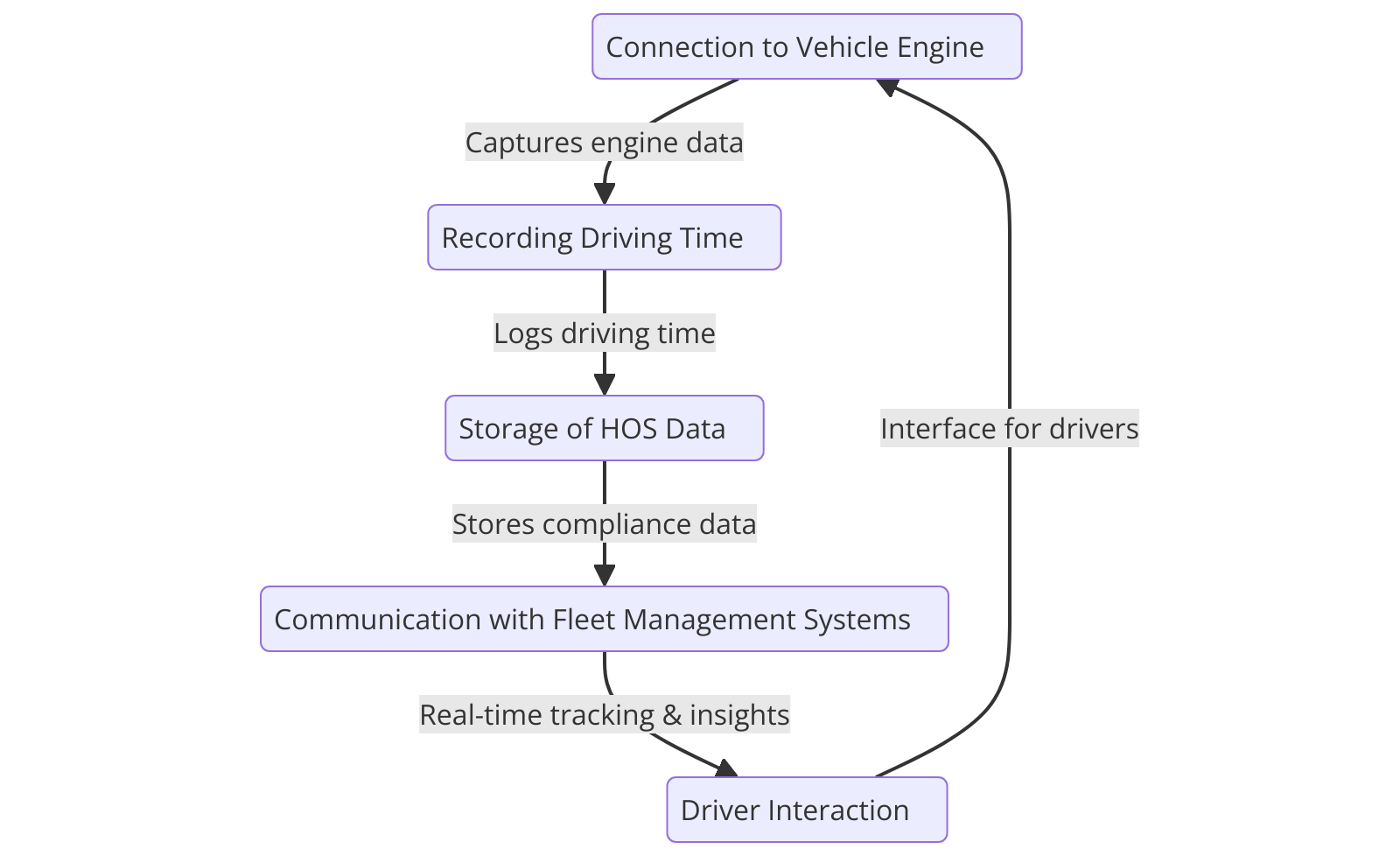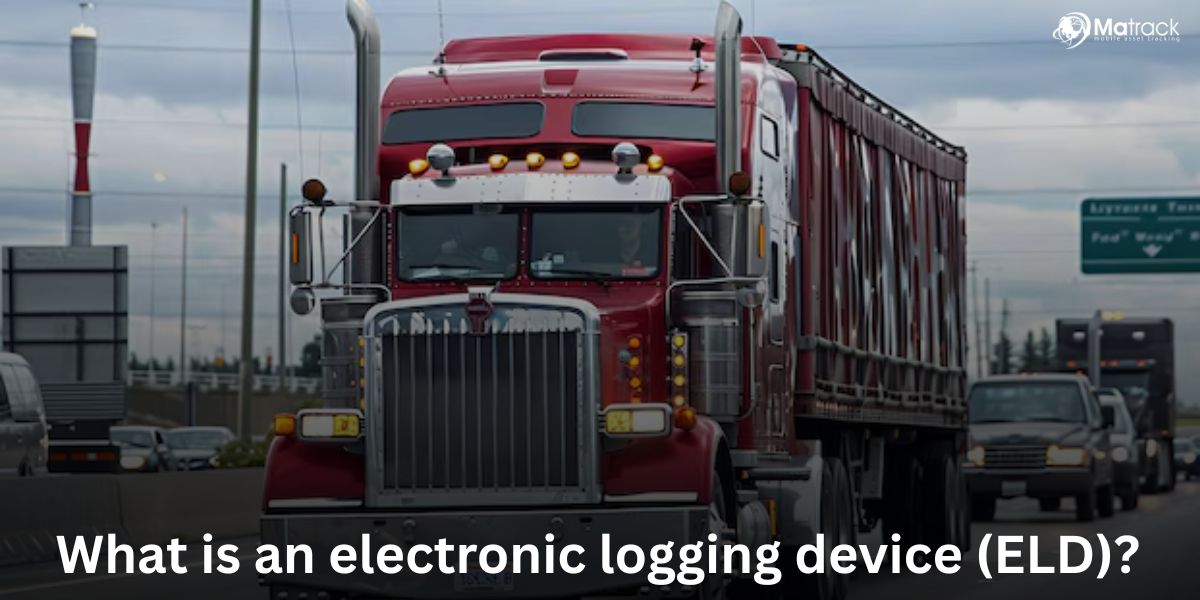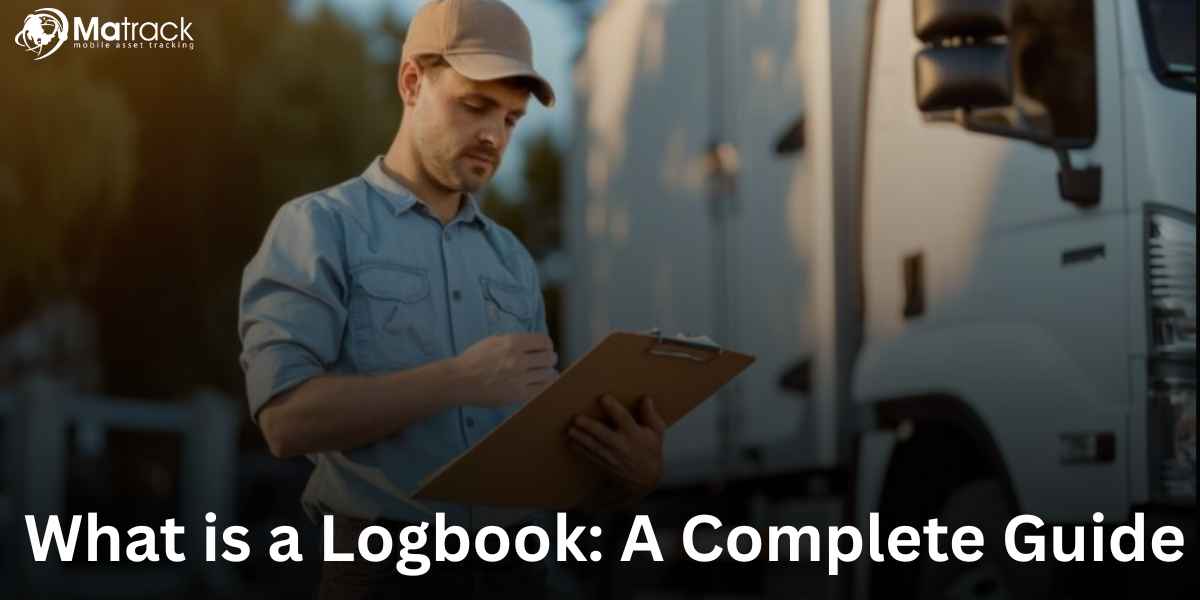Key Takeaways
- ELDs automatically track Hours of Service (HOS) to ensure compliance and replace manual logbooks with tamper-proof digital records.
- Matrack ELD simplifies fleet management with GPS tracking, DOT Inspection Mode, IFTA reporting, and a quick plug-and-play setup.
- ELDs improve safety, efficiency, and simplify inspections by automating compliance tasks and providing real-time data for better decision-making.
- To choose the right ELD, ensure it is FMCSA-certified, user-friendly, integrates with your systems, and fits your budget without hidden costs.
What is an electronic logging device?
Electronic Logging Device (ELD) connects to a truck’s engine to automatically track driving hours and engine activity. Its primary purpose is to record Hours of Service (HOS) data to ensure drivers follow safety regulations.
ELDs provide a convenient way for drivers to manage their records. They log essential information like the truck’s movement, engine hours, and location. With an easy-to-access display or app, drivers can view their remaining driving hours, putting them in control of their schedules.
These devices replace manual paper logs, ensuring recordkeeping is accurate and tamper-proof. This reliability gives fleet managers a sense of security, knowing that their drivers are staying compliant, improving safety, and reducing the chance of fines or violations.
How does an ELD work?

Connection to the Vehicle Engine
Connection to the vehicle engine is the first step in how an ELD works. The device is physically or wirelessly linked to the truck’s engine control module (ECM), allowing it to gather real-time data about the engine’s status, movement, and operation.
Recording Driving Time
Recording driving time is done automatically when the engine is running, and the truck is moving. The ELD can distinguish between driving time and activities like being off-duty or parked.
Storage of HOS Data
Storage of HOS data is a key feature of an ELD. It securely stores details like driving hours, rest periods, and other duty statuses needed for compliance.
Communication with Fleet Management Systems
ELD integration with telematics platforms allows fleet managers to communicate with fleet management systems, track driver compliance, monitor vehicle performance, and review driver behaviour in real-time.
Driver Interaction
Driver interaction with the ELD happens through an easy-to-use interface like a tablet, smartphone app, or dedicated screen. Drivers can log changes to their status, check remaining driving hours, and show logs during inspections.
Key features of an ELD
ELDs come with key features that make tracking and compliance easier and more reliable:
- Automatic Data Recording: The device automatically records driving hours, engine activity, vehicle movement, and location without any manual input.
- Driver Alerts: ELDs alert drivers when they are nearing their Hours of Service (HOS) limits to help avoid violations.
- Edit Log Capabilities: Drivers can make small edits to their logs if needed, but the original data is securely saved to prevent tampering.
- Inspection Reports: ELDs generate easy-to-read reports that drivers can show to officers during roadside inspections.
- Tamper Resistance: Built-in protections stop anyone from making unauthorized changes or altering the data.
- Integration Capabilities: Many ELDs can connect with telematics systems, giving fleet managers tools to monitor and manage operations more effectively.
These features make ELDs a reliable and efficient solution for managing driving hours and staying compliant with regulations.
Benefits of ELDs for truckers
Regulatory Compliance
Regulatory compliance is made easier with ELDs, as they automatically track driving hours and duty statuses. This helps truckers avoid violations, fines, and penalties by ensuring accurate HOS logging.
Increased Road Safety
Increased road safety is achieved because ELDs encourage adherence to HOS limits, reducing driver fatigue. By helping prevent fatigue-related accidents, ELDs contribute to a safer driving experience for everyone on the road. Find out how ELD has affected road safety.
Improved Operational Efficiency
Improved operational efficiency is another benefit of ELDs, as they provide data on fuel usage, idle time, and vehicle performance. This information helps fleet managers optimize routes, lower costs, and boost productivity.
Accurate Recordkeeping
Accurate recordkeeping is guaranteed with ELDs, which replace error-prone manual logs. ELDs create tamper-proof records that are easy to review during inspections or audits.
Driver Protection
Driver protection is enhanced with ELDs, as they provide clear and objective records of driving hours. These records shield drivers from being forced to exceed HOS limits by employers or dispatchers.
Simplified Inspections
Simplified inspections are possible thanks to the standardized logs generated by ELDs. This makes roadside checks quicker and less stressful for drivers. Also see: DOT Inspections.
What Is the ELD mandate?
The ELD mandate is a rule from the FMCSA that requires commercial drivers to use electronic logging devices (ELDs). These devices track Hours of Service (HOS) to ensure accurate recordkeeping and prevent fatigue.
The rule applies to most commercial vehicles in the U.S., but some are exempt. ELD exemptions include older vehicles made before 2000 and specific short-haul drivers.
How to choose the right ELD?
FMCSA Certification
Make sure the ELD you choose is certified by the FMCSA. Using a certified device ensures compliance and avoids fines or penalties.
Ease of Use
Pick an ELD that is simple to use and easy for drivers to understand. A user-friendly interface helps drivers log their hours and check records quickly.
Integration Features
Look for an ELD that works well with your fleet management system. Seamless integration allows for better monitoring and reporting of fleet performance.
Customer Support
Choose an ELD provider with strong customer support. Reliable assistance can help solve any issues quickly, keeping your operations on track.
Cost Structure
Consider the total cost of the ELD, including the upfront price and monthly fees. Make sure the device fits your budget while still meeting your needs.
Matrack for making regulatory compliance easy
Matrack ELD is a reliable, FMCSA-certified electronic logging device that makes HOS tracking and regulatory compliance easy for truckers and fleet managers. The device offers essential features like GPS tracking, DOT Inspection Mode, and IFTA reporting, ensuring smooth operations and avoiding penalties.
Matrack ELD is ready to use in just 5 minutes with its plug-and-play installation. The solution is cost-effective, with no upfront fees, no contracts, and a lifetime warranty, making it an ideal choice for fleets of all sizes.
Frequently asked questions
What is the difference between an AOBRD and an ELD?
An AOBRD tracks Hours of Service (HOS) but offers fewer features and less detailed data than an ELD. ELDs provide more precise tracking, engine connectivity, and stricter compliance with FMCSA regulations. Read about: Shifting From AOBRD To ELD.
What is the future of ELDs?
ELDs are expected to integrate advanced features like AI-driven analytics, better safety tools, and improved route optimization. These advancements will enhance fleet management and predictive maintenance capabilities.
What challenges do truckers face with ELDs?
Truckers face challenges like the cost of devices, technical issues, and adapting to new technology. Privacy concerns due to continuous monitoring are also common.
What information does an ELD record?
An ELD records driving time, engine hours, vehicle movement, location, and duty status changes. It also logs rest periods and off-duty hours.
How much do ELDs cost?
ELDs typically cost $150 to $500 upfront, with monthly subscription fees ranging from $15 to $50 per truck. Additional features can raise these costs.
Why are ELDs important?
ELDs ensure compliance with HOS regulations, improve road safety by reducing fatigue, and provide accurate, tamper-proof inspection logs. They also help optimize operations and cut down paperwork.
Can ELDs transfer data directly to the Department of Transportation?
Yes, ELDs can transfer HOS data to the DOT during inspections via email, USB, Bluetooth, or web services.
Is it mandatory for all drivers to use an ELD?
No, drivers of vehicles manufactured before 2000, specific short-haul drivers, and those not required to maintain HOS logs are exempt from the ELD mandate.
Conclusion
Electronic logging devices have become a vital part of modern trucking by making compliance easier and improving safety on the road. They provide an automated way to track driving hours and ensure smooth operations for both drivers and fleet managers.
Matrack ELD offers a practical solution with advanced features like GPS tracking and compliance tools. With its simple setup and no hidden costs, it helps fleets stay efficient while reducing stress for drivers.


